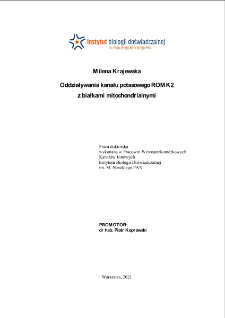- Wyszukaj w całym Repozytorium
- Piśmiennictwo i mapy
- Archeologia
- Baza Młynów
- Nauki przyrodnicze
Wyszukiwanie zaawansowane
Wyszukiwanie zaawansowane
Wyszukiwanie zaawansowane
Wyszukiwanie zaawansowane
Wyszukiwanie zaawansowane

Obiekt
Tytuł: Oddziaływania kanału potasowego ROMK2 z białkami mitochondrialnymi : praca doktorska
Twórca instytucjonalny:
Instytut Biologii Doświadczalnej im. Marcelego Nenckiego PAN
Współtwórca:
Wydawca:
Instytut Biologii Doświadczalnej im. M. Nenckiego PAN
Miejsce wydania:
Opis:
202 strony : ilustracje ; 30 cm ; Bibliografia ; Streszczenie w języku angielskim
Uzyskany tytuł:
Dyscyplina :
Instytucja nadająca tytuł:
Instytut Biologii Doświadczalnej im. Marcelego Nenckiego PAN ; nadanie stopnia: 27.04.2022
Typ obiektu:
Abstrakt:
Niedotlenienie/reperfuzja serca oraz mózgu prowadzi do uszkodzenia i śmierci komórek i jest najczęstszą przyczyną zgonów w krajach rozwiniętych. Wydaje się, że kanały mitochondrialne biorą udział w cytoprotekcji w czasie reperfuzji. Jednym z nich jest mitochondrialny kanał potasowy hamowany przez ATP (mitoKATP). Zaproponowano, że ROMK2 może być podjednostką mitoKATP. ROMK2 jest izoformą białka ROMK1 tworzącego kanały potasowe w błonie komórkowej. Kanały te oddziałują z wieloma białkami uczestniczącymi w regulacji ich aktywności i transporcie w komórce. Dotychczas niezidentyfikowane zostały żadne białka oddziałujące z ROMK2 w mitochondriach. Głównym celem badań prezentowanych w tej rozprawie doktorskiej była identyfikacja białek wchodzących w skład najbliższego otoczenia kanału ROMK2. W tym celu wykorzystano metodę metody biotynylacji białek sąsiadujących. Wśród biotynylowanych białek znaleziono białka cytoplazmatyczne biorące m.in. udział w endocytozie, transporcie pęcherzykowym, stresie oksydacyjnym, syntezie nukleotydów, czy metabolizmie lipidów. Zidentyfikowano ponadto białka kompleksów translokaz uczestniczących w imporcie białek przez zewnętrzną i wewnętrzną błonę mitochondriów. Wśród podjednostek tych translokaz znaleziono kinazę acyloglicerolową (AGK), która oprócz importu politopowych białek do wewnętrznej błony mitochondrialnej uczestniczy w syntezie lipidów: kwasu lizofosfatydowego (LPA) oraz kwasu fosfatydowego (PA). Poprzez koimmunoprecypitację udowodniono istnienie kompleksu zawierającego ROMK2 i AGK. Kolejnym celem były badania nad farmakologiczną modulacją aktywności kanału ROMK2. W celu realizacji tych badań białko ROMK2-6xHis produkowano w bakteriach Escherichia coli; błony bakteryjne solubilizowano przy pomocy amfipatycznych kopolimerów, a białko kanałowe oczyszczono poprzez chromatografię metalopowinowactwa. Badania aktywności elektrycznej ROMK2-6xHis prowadzono stosując technikę planarnych dwuwarstw lipidowych. Sprawdzono wpływ znanych modulatorów kanału mitoKATP na aktywność białka ROMK2. Aktywność kanałowa ROMK2 stymulowana była przez aktywator mitoKATP diazoksyd i blokowana przez znane jego inhibitory, tj. ATP/Mg2+, 5-HD oraz glibenklamid. Wyniki te są zgodne z hipotezą, że białko ROMK2 może być podstawową jednostką budującą mitoKATP. Badania te dodatkowo wykazały, że wpływ tych modulatorów był bezpośredni, a nie związany z obecnością białek akcesoryjnych. W końcu wykazano funkcjonalną interakcję pomiędzy ROMK2, a AGK, gdyż produkty enzymatycznej aktywności białka AGK, tj. LPA i PA regulowały aktywność kanału ROMK2.
Szczegółowy typ zasobu:
Identyfikator zasobu:
Źródło:
IBD PAN, sygn. 19934 ; kliknij tutaj, żeby przejść
Język:
Język streszczenia:
Prawa:
Prawa zastrzeżone - dostęp nieograniczony
Zasady wykorzystania:
Właściciel praw autorskich:
Publikacja udostępniona za pisemną zgodą autora
Digitalizacja:
Instytut Biologii Doświadczalnej im. Marcelego Nenckiego Polskiej Akademii Nauk
Lokalizacja oryginału:
Biblioteka Instytutu Biologii Doświadczalnej im. Marcelego Nenckiego PAN
Dostęp:
Kolekcje, do których przypisany jest obiekt:
- Repozytorium Cyfrowe Instytutów Naukowych > Kolekcje Partnerów > Instytut Biologii Doświadczalnej PAN
- Repozytorium Cyfrowe Instytutów Naukowych > Kolekcje Partnerów > Instytut Biologii Doświadczalnej PAN > Prace dyplomowe
- Repozytorium Cyfrowe Instytutów Naukowych > Kolekcje Partnerów > Instytut Biologii Doświadczalnej PAN > Prace dyplomowe > Prace doktorskie
- Repozytorium Cyfrowe Instytutów Naukowych > Piśmiennictwo
- Repozytorium Cyfrowe Instytutów Naukowych > Piśmiennictwo > Prace dyplomowe
Data ostatniej modyfikacji:
16 gru 2024
Data dodania obiektu:
21 kwi 2022
Liczba pobrań / odtworzeń:
307
Wszystkie dostępne wersje tego obiektu:
https://rcin.org.pl./publication/271853
Wyświetl opis w formacie RDF:
Wyświetl opis w formacie RDFa:
Wyświetl opis w formacie OAI-PMH:
| Nazwa wydania | Data |
|---|---|
| Krajewska, Milena | 16 gru 2024 |
Obiekty Podobne
Sęk, Aleksandra
Rotko, Daria
Konopacki, M. [Mieczysław]
Piecyk, Karolina
Wołosiewicz, Marcin
Krupska, Olga
Prill, Monika
Simões, Inês

 INSTYTUT ARCHEOLOGII I ETNOLOGII POLSKIEJ AKADEMII NAUK
INSTYTUT ARCHEOLOGII I ETNOLOGII POLSKIEJ AKADEMII NAUK
 INSTYTUT BADAŃ LITERACKICH POLSKIEJ AKADEMII NAUK
INSTYTUT BADAŃ LITERACKICH POLSKIEJ AKADEMII NAUK
 INSTYTUT BADAWCZY LEŚNICTWA
INSTYTUT BADAWCZY LEŚNICTWA
 INSTYTUT BIOLOGII DOŚWIADCZALNEJ IM. MARCELEGO NENCKIEGO POLSKIEJ AKADEMII NAUK
INSTYTUT BIOLOGII DOŚWIADCZALNEJ IM. MARCELEGO NENCKIEGO POLSKIEJ AKADEMII NAUK
 INSTYTUT BIOLOGII SSAKÓW POLSKIEJ AKADEMII NAUK
INSTYTUT BIOLOGII SSAKÓW POLSKIEJ AKADEMII NAUK
 INSTYTUT CHEMII FIZYCZNEJ PAN
INSTYTUT CHEMII FIZYCZNEJ PAN
 INSTYTUT CHEMII ORGANICZNEJ PAN
INSTYTUT CHEMII ORGANICZNEJ PAN
 INSTYTUT FILOZOFII I SOCJOLOGII PAN
INSTYTUT FILOZOFII I SOCJOLOGII PAN
 INSTYTUT GEOGRAFII I PRZESTRZENNEGO ZAGOSPODAROWANIA PAN
INSTYTUT GEOGRAFII I PRZESTRZENNEGO ZAGOSPODAROWANIA PAN
 INSTYTUT HISTORII im. TADEUSZA MANTEUFFLA POLSKIEJ AKADEMII NAUK
INSTYTUT HISTORII im. TADEUSZA MANTEUFFLA POLSKIEJ AKADEMII NAUK
 INSTYTUT JĘZYKA POLSKIEGO POLSKIEJ AKADEMII NAUK
INSTYTUT JĘZYKA POLSKIEGO POLSKIEJ AKADEMII NAUK
 INSTYTUT MATEMATYCZNY PAN
INSTYTUT MATEMATYCZNY PAN
 INSTYTUT MEDYCYNY DOŚWIADCZALNEJ I KLINICZNEJ IM.MIROSŁAWA MOSSAKOWSKIEGO POLSKIEJ AKADEMII NAUK
INSTYTUT MEDYCYNY DOŚWIADCZALNEJ I KLINICZNEJ IM.MIROSŁAWA MOSSAKOWSKIEGO POLSKIEJ AKADEMII NAUK
 INSTYTUT PODSTAWOWYCH PROBLEMÓW TECHNIKI PAN
INSTYTUT PODSTAWOWYCH PROBLEMÓW TECHNIKI PAN
 INSTYTUT SLAWISTYKI PAN
INSTYTUT SLAWISTYKI PAN
 SIEĆ BADAWCZA ŁUKASIEWICZ - INSTYTUT TECHNOLOGII MATERIAŁÓW ELEKTRONICZNYCH
SIEĆ BADAWCZA ŁUKASIEWICZ - INSTYTUT TECHNOLOGII MATERIAŁÓW ELEKTRONICZNYCH
 MUZEUM I INSTYTUT ZOOLOGII POLSKIEJ AKADEMII NAUK
MUZEUM I INSTYTUT ZOOLOGII POLSKIEJ AKADEMII NAUK
 INSTYTUT BADAŃ SYSTEMOWYCH PAN
INSTYTUT BADAŃ SYSTEMOWYCH PAN
 INSTYTUT BOTANIKI IM. WŁADYSŁAWA SZAFERA POLSKIEJ AKADEMII NAUK
INSTYTUT BOTANIKI IM. WŁADYSŁAWA SZAFERA POLSKIEJ AKADEMII NAUK




































